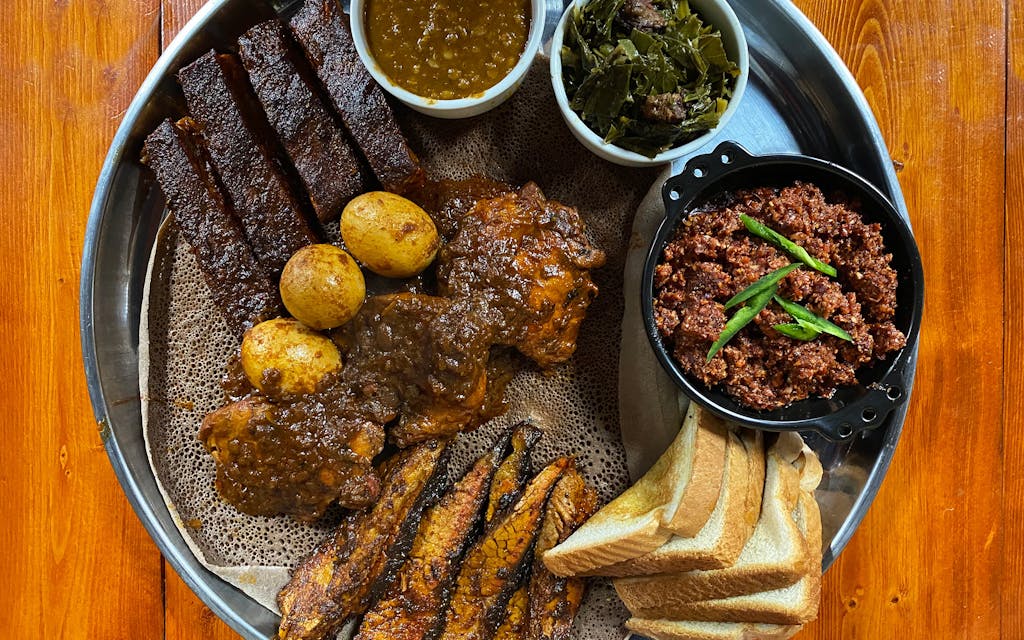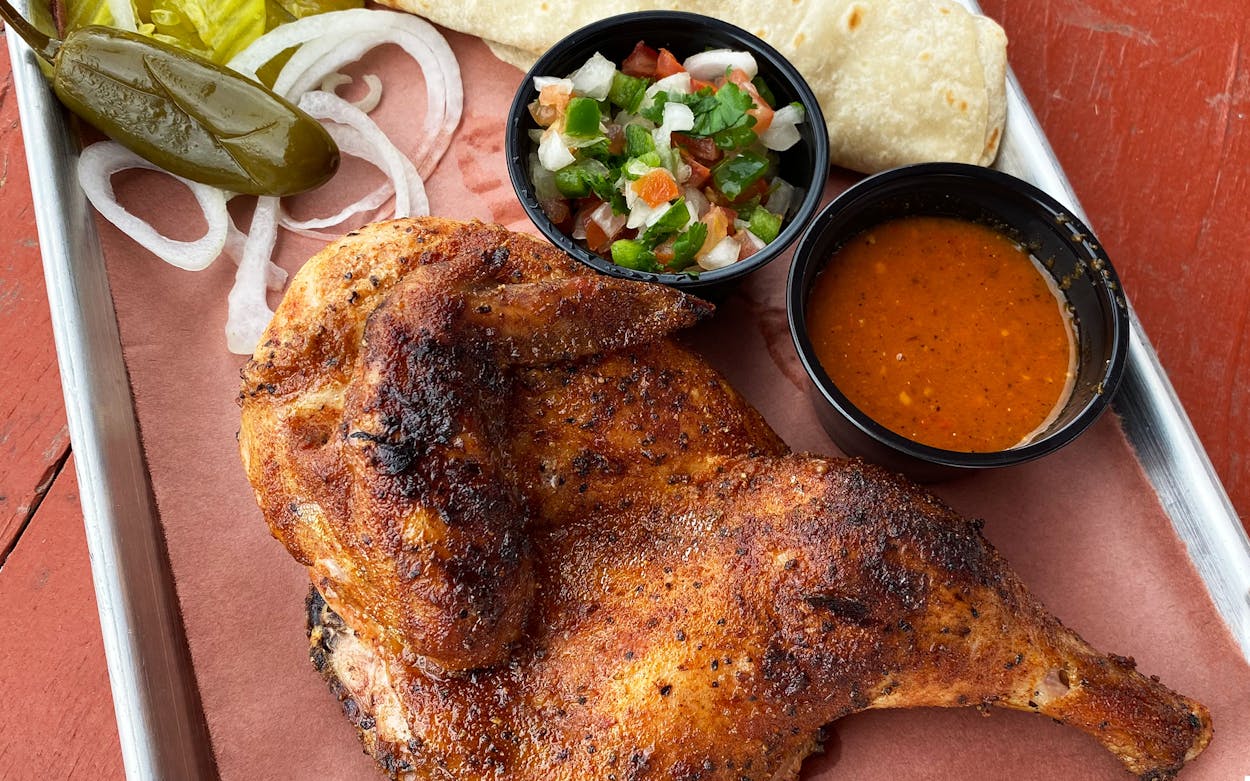For more than a decade, chicken has been losing ground to turkey in the smoked poultry battle in Texas. A smoked turkey breast cooks more consistently, keeps better in a warmer, and can be portioned more easily into small servings for combo plates. Half or quarter chickens can be a pain to cook and serve, but they’re more delicious. When you get the right combination of juicy meat and crisp skin, it beats a great slice of turkey any day. Luckily, chicken is mounting a revival.
Plenty of classic spots have always offered chicken and still smoke it incredibly well, including Dozier’s in Fulshear and City Meat Market in Giddings. Both joints serve up a beautiful bird with black pepper–flecked skin and juices running onto the butcher paper. Just up the road from Giddings is Snow’s BBQ in Lexington, where pitmaster Tootsie Tomanetz mops half chickens that sizzle for hours directly over wood coals. It’s often one of the first items to run out every Saturday. Down in Hallettsville at Kolacny Bar-B-Q, Ervin Kolacny uses the same direct-heat method to similar effect on some of the least expensive barbecue chicken in Texas, at just $4 a half. After one bite into the salty thigh while standing over your car’s trunk (there’s no seating inside Kolacny Bar-B-Q) with juices running down your forearms, you’ll know a bird of that quality is worth plenty more.
Direct heat, which uses hot wood coals for cooking, is an older method of producing barbecue than burning logs in the firebox of an offset smoker. The higher heat helps crisp the skin more efficiently, and a mop sauce—often made with mustard, vinegar, and butter—produces a flavor that can’t be replicated inside the chamber of a low-and-slow offset smoker. The realization of that truth, along with the rapid proliferation of BQ Grills in Texas, has brought about more great chicken halves. The North Carolina–built BQ grill is a portable, direct-heat apparatus designed for whole-hog barbecue, and lots of Texas barbecue joints have added one to their pit rooms. When there’s not a hog inside, those grills are great for cooking chicken.
In Houston, J-Bar-M BBQ purchased two BQ grills, hoping to make whole-hog a regular feature. One of the grills is in everyday use, filled with half chickens available to order daily. They’re rubbed, mopped, and cooked until tender and juicy. Trevor Sales uses a similar method at Brix Barbecue in Fort Worth, but his Friday-only half chickens start in a chimichurri marinade overnight. The combination of cilantro, parsley, garlic, jalapeños, and lime juice brings a brightness to the meat, and a fresh cup of chimichurri comes on the side to further liven it up. Pair the chicken and sauce with house-made pickles and fresh flour tortillas. Sales also reminded me why it pays to serve great chicken at a Texas barbecue joint: “Compared to beef prices, it’s the way to go.”
For another great DIY chicken taco, head to Teddy’s Barbecue in Weslaco. Owners Joel and Jesse Garcia toyed with having a weekly pollo asado special before making it available every day. Unlike their oak-smoked, salt-and-pepper briskets, the brothers’ chicken halves are seasoned with granulated garlic, black pepper, and Season-All. The last was chosen because it provides the flavor and the smell the Garcias know from the pollo asado they had growing up. They cook the chicken for about ninety minutes over mesquite coals in a Chudbox designed for direct-heat cooking, and they serve it with house-made salsa and pico de gallo. Their mother rolls out up to 150 flour tortillas every day, so add a couple to your plate.
Ernest Servantes calls the Friday-only special at Burnt Bean Co. in Seguin his Tijuana chicken. It wasn’t inspired by any chicken he had in the Mexican border city, but he needed a name for his nontraditional take on the mayonnaise-based Alabama white sauce. He adds cilantro, ancho chiles, chipotles, and adobo to the mix, then slathers it on the finished chicken. The half chicken begins cooking on the smoker but is finished to order on a screaming-hot charcoal grill. Pull off some of the juicy meat and skin and stuff it into a flash-fried corn tortilla (they’re not fried until hard—the short time in the oil makes the tortillas pliable and more resistant to drying out). Scoop in the molcajete salsa, charred jalapeños, and paper-thin pickled onions, and squeeze on some charred lime for possibly the best barbecue chicken taco in existence.
The final step of applying high heat to chicken skin isn’t unique to Burnt Bean, but is important to stave off the flabby skin that can develop from prolonged holding in a warmer. Slow Bone in Dallas purposely undercooks its smoked chickens, chills them, then finishes them in a hot oven, one sheet pan at a time, as needed for service. At Distant Relatives in Austin, the skin on the smoked chicken quarters is shatteringly crisp because it’s sautéed in hot brown butter just before serving. When Phillip Helberg added smoked chicken to the Helberg Barbecue menu outside Waco, he knew he could improve it. “Is there a way to make this juicy but with perfectly crispy skin every time?” he wondered. After a few iterations, the preferred method was smoking brined chicken halves (“brining is the key to any good chicken,” Helberg insisted) and pulling them just before they’re fully cooked. The final step, after a customer orders a chicken half, is to drop it into a deep fryer filled with hot beef tallow. The skin gets as crisp as that of fried chicken. Wade Elkins at Mimsy’s Craft Barbecue in Crockett admits the Helberg method was the inspiration for his smoked-and-fried chicken. I was plenty impressed with the two-day brined chicken even before the joint started frying them.
A few Texas joints add smoke flavor to chicken recipes that are not normally smoked. The jerk chicken quarters are a monthly special at Cattleack Barbeque in Dallas (check its social media for a schedule) that starts with three days of marinating. Owner Todd David is still awaiting his jerk chicken pilgrimage to Jamaica, but he did his research for the marinade, the base of which is ginger, garlic, green onions, allspice, and Jamaican scotch bonnet peppers. “I think the scotch bonnets make a difference,” he said, as opposed to the more readily available habanero peppers. David has them shipped from an importer in Miami. He insists on using only Jamaican allspice as well. The chicken is cooked over direct heat (on another BQ grill) for a couple hours, then basted with a jerk barbecue sauce that’s a sweeter version of the spicy marinade. To maintain the crisp skin, the chicken is the last thing that comes off the pit before Cattleack opens, and it typically sells out in the first hour.
If you miss out, there’s another great jerk chicken option just up the road. The new Willie Meshack’s BBQ in Plano (no affiliation with Meshack’s Bar-Be-Cue in Garland) was opened by the same family that runs Caribbean Cabana in the Dallas Farmers Market. Willie’s wife, Roberta Plaza, hails from Trinidad and Tobago. Her family has always made jerk chicken with habaneros, and so does the restaurant. At Willie Meshack’s, the chicken tenderizes in the jerk marinade for two days before it’s smoked until tender, then finished on a hot grill after it’s ordered. The cloud of smoke that hangs in the dining room is evidence of the jerk chicken’s popularity. Its moderate spice can be kicked up with a squeeze of the Trinidadian hot sauce.

Doro wat is a traditional Ethiopian stew made with skinless, bone-in chicken. Smoke ’N Ash BBQ in Arlington makes its doro wat with smoked chicken. Owners Patrick and Fasicka Hicks rub the thighs with Ethiopian berbere spice and minced garlic before smoking them for about an hour. They finish cooking in the sauce, which has a blend of shallots, red onions, garlic, and ginger. “The smoke from the chicken changes everything in the pot,” Fasicka said. Each batch requires a whole bunch of onions, about ten pounds for twenty servings, and Fasicka chops them by hand. “I bought some goggles to stop me from crying,” she said. I wondered if her Ethiopian clientele was thrown off by the smoke flavor in the doro wat, and she said no. In Ethiopia, it’s common to cook over an open flame, so the flavor from the smoked chicken “reminds them of the old way of cooking doro wat,” she said.
Chicken isn’t as cheap as it used to be, but it’s still a lot less expensive than beef—and it cooks more quickly. The challenges of holding it in a warmer are easy enough to overcome, but the functionality of chicken isn’t why it should make a strong comeback in Texas barbecue. Chicken is so versatile, takes on seasonings well, and is delicious when done right. That’s why I’m hoping—and expecting—to see more barbecue menus highlighting creative ways of preparing chicken.
- More About:
- Chicken








